Review: Seacam Remote Strobe Trigger

Off-camera flash has been one of the techniques that falls in and out of fashion in underwater photography. By moving a strobe or strobes off the camera, it removes many of the problems associated with lighting in challenging conditions. For wide angle shooters, it lets you light up areas that your strobes would never be able to actually reach, adds depth to images, dramatically reduces backscatter and allows creative, atmospheric lighting effects. For macro photographers, being able to aim snoots without having them physically attached to the housing makes the frustrating “art” of snoot lighting much more straightforward. Simply put the snooted strobe onto a Gorillapod or get a buddy to hold and aim it and then use a remote trigger to fire it.
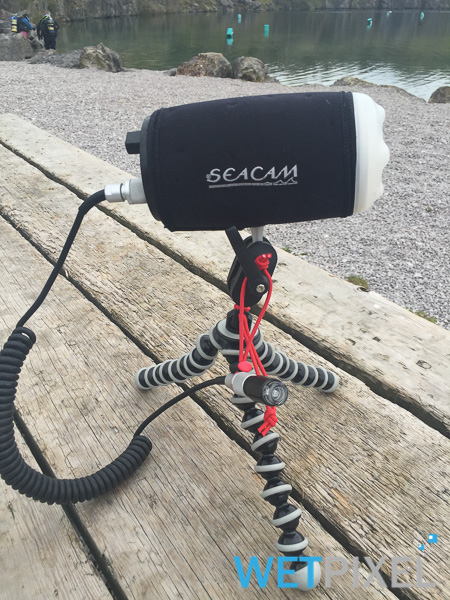
In general, studio photographers tend not to have their flashes attached to the camera as this gives them better control and greater creative lighting opportunities. Of course, they also do not have to cope with particles in the water column!
Optical triggers have also been around for a while. Many current strobes actually have optical slave triggers built-in to them, and Ikelite have had an external Slave Sensor available for their Substrobes since the nineties. The problem with integral slave triggers is that in order for them to trigger reliably, they must be in line of sight with the command strobe, and this normally means that they are visible in the image too. The very bright light output close to the strobe creates exposure problems too. This limits where you can place the strobes for best effect.
Hence the need for a remote optical strobe trigger. If the trigger is attached to a short cable, the strobe can be secreted out of shot. The trigger can then be simply cloned out in Photoshop if required. There are currently a number of underwater optical remote strobe triggers available from Ikelite, Heinrichs Weikamp, Fun-In and others.
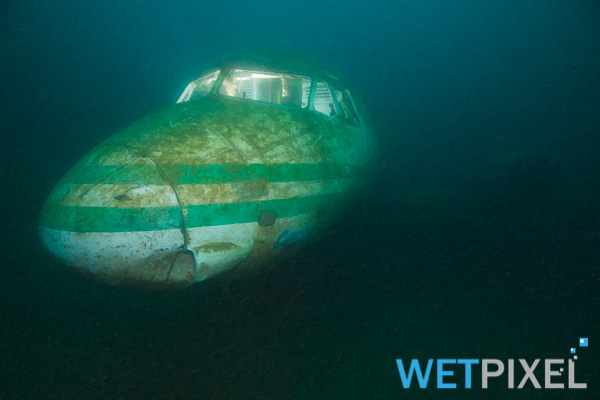
In order for the technique to work, it is best to use powerful strobes for off-camera work. The more power available, the better the effect typically seems to be. If you are attempting to light up part of a wreck for example, by moving some distance from remote strobe its light is by definition significantly dissipated. If a snoot is used the light is attenuated as it passes through the lenses or light directors and there is an inevitable net drop in output. This is true even with devices that efficiently refocus the light like Retra’s LSD. It is always best to start with more strobe power than you think you may need, as it can always be turned down.

Seacam are well known for producing powerful strobes, however as the company typically ships its strobes with an S6 connection, this has limited options for remote triggering somewhat. At DEMA 2015, Harald Hordosch of Seacam showed me a new trigger specifically designed for use with Seacam strobes and at the BOOT show in January, he kindly supplied a sample for Wetpixel to test.
Seacam Remote Strobe Trigger

The trigger is available to order with either S6 or Nikonos fittings, although it only compatible with Seacam strobes. The S6 version has the standard triple O ring seal. It consists of an optical sensor that detects the triggering flash and then a converter that triggers the remote strobe. It is powered via the strobe’s own battery, so no external power or batteries are required.

Please bear in mind that this unit will work in manual mode only and does not offer TTL exposure control or slaving. It will work with rear curtain sync as it will simply mimic the triggering strobe’s flash timing.
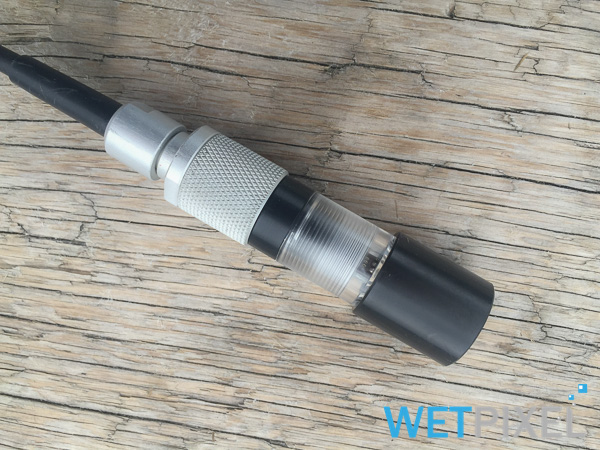
Its body is constructed of anodized aluminum and it has an acrylic lens. A black nylon sleeve is supplied that can be fitted over the lens. This is held in place by an O ring in the sensor’s body. It directs the sensor, reducing the chances of it being fired inadvertently by extraneous light sources. If this “directionality” is not required, the sleeve can be reversed and parked on the trigger’s body.

The whole unit is very small and compact and occupies no extra space in a photographer’s gear bag.
Testing
The test set up that was used was a Seaflash 150D strobe mounted on a Gorillapod. This was to be triggered by another Seaflash mounted on the camera. Both strobes were set in manual mode, with the remote set to full power, and the triggering strobe adjusted according to need.
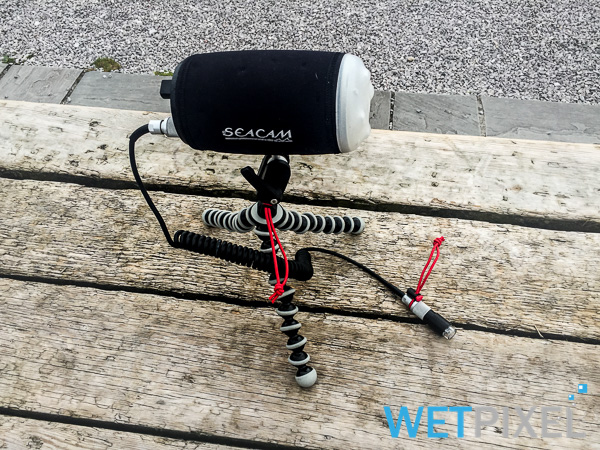
The strobes were fitted with diffusers, although in retrospect, I think that this is a mistake for the triggering strobe. Diffusers soften, lessen and broaden strobe output, which is not required or needed in a strobe that is solely used for triggering.
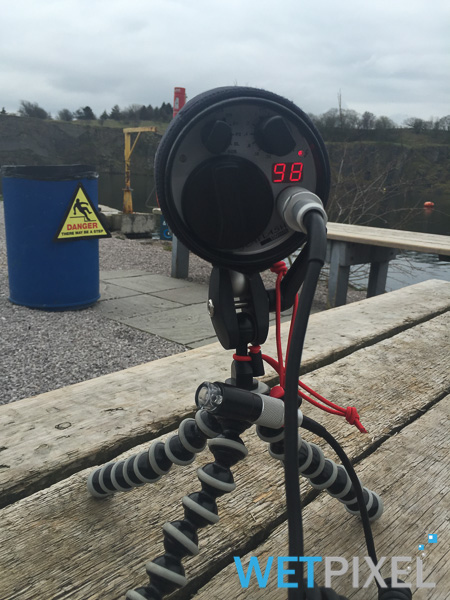
Test conditions were challenging from a photographic point of view. There was low ambient light, with a lot of particulate in the water. Conventional on-camera strobe techniques would have been limited due to the amount of backscatter that the strobe’s output would have created.
In terms of testing the trigger however, low light will actually tend to improve their performance. As it actually detects contrast in order to trigger, low light levels equal more contrast. They are amazingly reliable in caves or other very dark places! However, the particulate in the water makes it harder for the triggering strobe’s output to reach the slave trigger. Hence it needs more sensitivity in order to function.
To try and illustrate the conditions during testing, here is a short video:
Sensitivity:
Under the conditions of the test, the trigger fired affectively at ranges of up to 12 meters (40 feet). In order to do so, the triggering strobe on the camera was set at no more than half power. At 15 meters (50 feet), the trigger was sufficiently reliable although not 100%. I did not increase the triggering strobes power as this would have resulted in issues with backscatter.
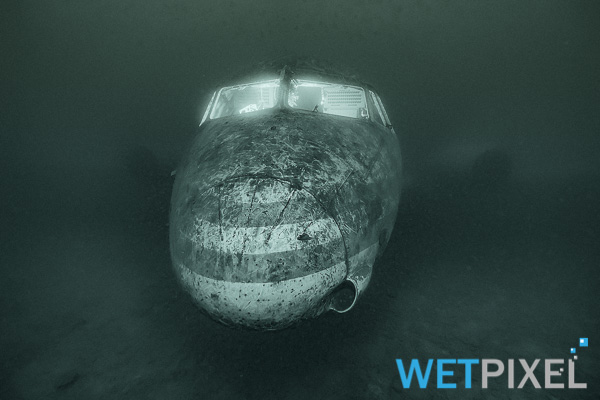
For all practical purposes, 12 meters is more than far enough. Outside of night or cave photography, the output of the remote strobe is significantly diminished beyond this range, losing its effect.
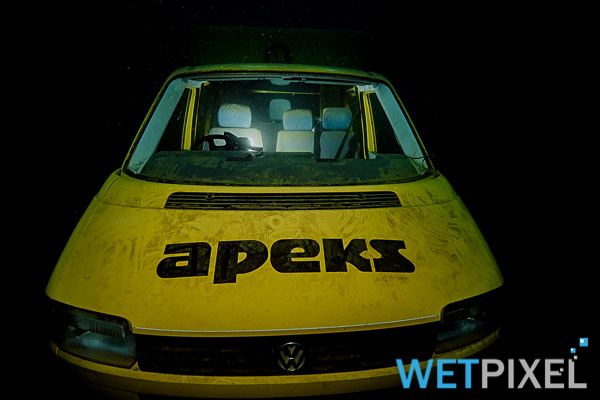
What is fairly critical however is that the trigger is oriented towards the triggering strobe correctly, particularly if it is at some distance from it. During the above video, you can see an instance in which I have moved towards the left hand side and the trigger did not fire. By re-aligning it, reliability was again achieved.
For use as a trigger for a snooted strobe, range is not an issue, although it is important to consider alignment. If you are locating the snoot to one side, you may need to either orientate the triggering (camera mounted) strobe to point in the direction of the trigger, or move the trigger into a position where there it is oriented to point directly at the camera mounted strobe. Certainly, if you are diving in a group, this would be a good time to use the “focusing sleeve” to eliminate false triggering. This is more than a simple nuisance as at full power most strobes take a little while to recycle. It is not ideal to be missing crucial images of behavior because your strobe has just fired inadvertently and has not recycled yet.
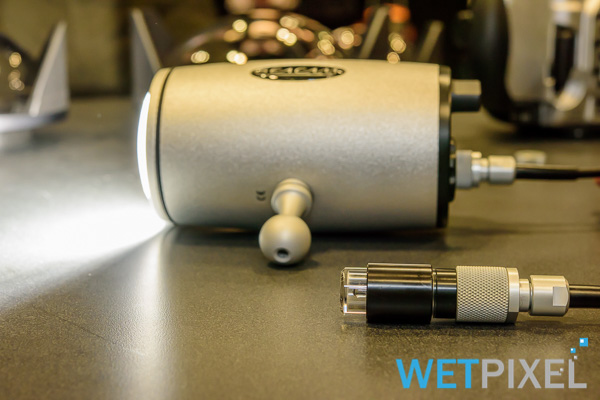
Again, the video above shows that when using a remote flash, it is a good time to dive with a buddy or assistant. Swimming in and out to reposition the trigger/strobe becomes quite tedious.
The trigger itself is small and light and a tiny bit negatively buoyant. This is good as it means that it tends to stay put and most importantly, does not float off. To carry and rig the remote strobe, I used two Think Tank Red Whips, one on the trigger and one on the ball mount on top of the Gorillapod, which I then clipped into using a double ended bolt snap. I use the Red Whips to control my strobe cables normally, so have them. I am sure that other bungee/cord lock products will do the job just as well too!
Although I have no problem with my solution, it would be nice to have an attachment eyelet or ring on the trigger.

My only other niggle is that it would be good to have a squared off or flat side on the trigger. As it is entirely cylindrical, it tends to roll quite easily, and does not sit flat when attached to an object.
Setting up the trigger is very easy. Simply attach it to the S6 cable, attach the other end to the strobe, set the strobe to manual and you are in business. There are no user adjustable settings on it. As always, it is wise to check the O rings on the S6 connection and to be careful when aligning the connection pins.

Initially, it is wise to start with the remote strobe to be on full power, and the triggering strobe to be on minimum power. The latter can be adjusted according to the distance away from the trigger, and the creative effect required (you may want to light using the on-camera strobe too).
Conclusion
Off camera lighting is an important tool in the underwater photographer’s arsenal. Typically, it is not possible to have too much strobe power when utilizing this technique.
Seacam’s new remote trigger allows the use of Seacam strobes with an S6 connection and is small and light. It is easy to use and very well made. Perhaps more importantly, it provides reliable and consistent triggering at the distances required.
If you own an S6 equipped Seacam strobe and are interested in using more creative lighting techniques, this is an important tool.
The Seacam Remote Strobe Trigger is available now. Please contact your local Seacam dealer or email email Seacam head office for more details.
FTC Disclosure
Seacam supplied the remote trigger an an S6 cable for use on this review. The strobes were the reviewer’s own. Many thanks to Harald Hordosch for his assistance.